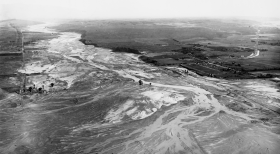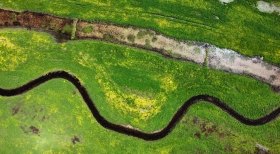
Engineering sustainable solutions for tomorrow’s world.
SWCA has a highly qualified team of engineers, landscape architects, scientists, planners, and cultural and natural resources experts that blend science with innovation to restore ecosystems. SWCA specializes in ecological restoration engineering and water quality remediation of the physical and biological environment, working in systems such as streams, wetlands, and coastal shorelines to improve water quality and support a diverse aquatic community. The engineering team also provides civil site development services for the energy related industries including preliminary civil construction layouts, drainage plans, pre- and post-construction stormwater management, floodplain engineering, and final construction plans.
Relevant Services
- As-Built Reviews
- Coastal Resiliency
- Construction Compliance Inspectors
- Construction Cost Estimates
- Construction Phase Services
- Dam Removal and Decommissioning Plans
- Design and Build Restoration
- Drainage and Grading Plans
- Ecological Restoration
- FEMA & Floodplain Permitting/Analysis
- Fish Passage
- Hydrologic and Hydraulic Analysis
- Hydrologic/Hydrographic Surveying
- Land Surveying
- National Pollutant Discharge Elimination System Permits (NPDES)
- Nature-Based Solutions
- Renewable Energy Site Development
- Spill Prevention, Control, and Countermeasure Plans
- Stormwater Management/Quality
- Stormwater Pollution Prevention Plans Prevention plans
- Stream/Wetland Restoration
- Topographic/Bathymetric Surveying
Project Spotlights

Nature-Based Solutions
Driving Nature-Based Solutions Forward: Living Shorelines Stabilize Critical Evacuation Route Along North Carolina Coastal Highway
Living shorelines are a nature-based approach to bolster coastal areas that are susceptible to erosion from sea level rise, natural disasters, and human activity. Made of native vegetation and other natural materials like oyster reefs and rock sills, living shorelines are an alternative to conventional, hard shoreline stabilization methods like stone bulkheads or sheet piling that can degrade essential habitat. Using nature to stabilize shorelines protects, restores, and enhances the surrounding ecosystem.
“Natural designs like living shorelines are a more resilient, cost-effective, and sustainable approach to stabilizing coastlines that all aspects of the ecological restoration industry — consultants, municipalities, government agencies — are moving towards,” said Kelli Gallt, lead designer and an associate project restoration engineer at SWCA.

Mitigation Banking
When it Rains, it Pours: How One Man’s Con Set the Stage for a River’s Destruction and Restoration
When San Diego was facing a historic drought in 1915, the city council turned to an unlikely character to solve their crisis: Charles Hatfield, a 40-year-old sewing machine salesman and “rainmaker.”
“What followed in January and early February of 1916 was a downpour — 30 inches of rain by some estimates. Mission Valley flooded. The San Diego River jumped its banks. Farms, homes, bridges and businesses were swept away. Estimates of the deaths range from a dozen to 50.”

Stream and Wetland Restoration
Water, Water, Everywhere: Stream and Wetland Restoration in North Texas
An afternoon thunderstorm rolls across the plains of northern Texas and on the banks of the Red River, the former cattle pastures and agricultural fields at Riverby Ranch slowly begin to fill with water. But there is no cause for concern; in fact, everything is going according to plan. As the North Texas Municipal Water District (NTMWD) creates the area’s first major reservoir in nearly 30 years only a few miles from the Ranch, SWCA’s stream and wetland restoration plans will offset habitat lost to the new lake’s rising waters with a flood of its own – creating protected waterways and wetlands where cattle once grazed.

Bank Stabilization
Going Against the Flow: Using "Soft Engineering" to Solve Age-Old Problems on the Connecticut River
The Connecticut is a river that many take for granted. Nationwide, it may not have the notoriety of the Mississippi, the Rio Grande, or the Colorado. But it is the longest river in New England, etching a course more than 400 miles long from the Quebec border south through four U.S. states. Its watershed is vast, and it supplies 70 percent of Long Island Sound’s fresh water. It has more than 1,000 dams on its tributaries and 16 dams on its main stem, a dozen of which are hydropower projects.
So, famous or not, when forces threaten the shorelines of the Connecticut, people take notice.
For the past 20 years, the Amherst office has been engaged in the evaluation, permitting, design, and construction of bank stabilization projects on a 22-mile stretch of riverbank on the Connecticut River. We have worked with landowners, regulatory agencies, municipalities, stakeholder groups, and other entities interested in the ecological restoration of riverbanks.
















